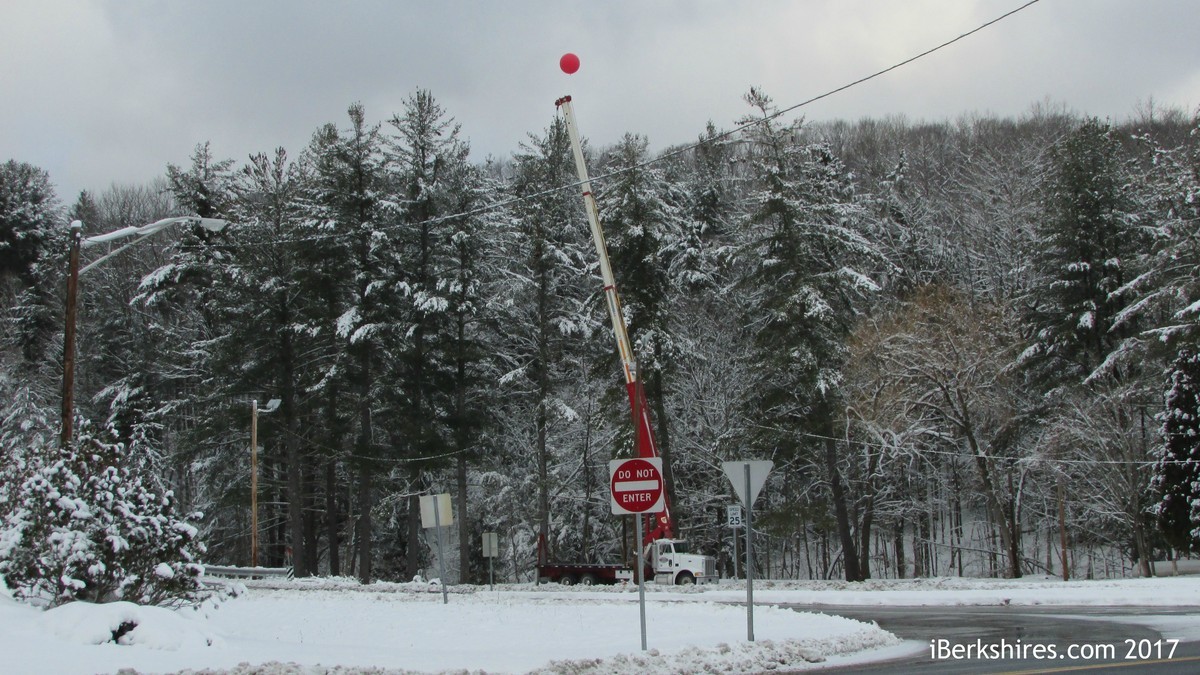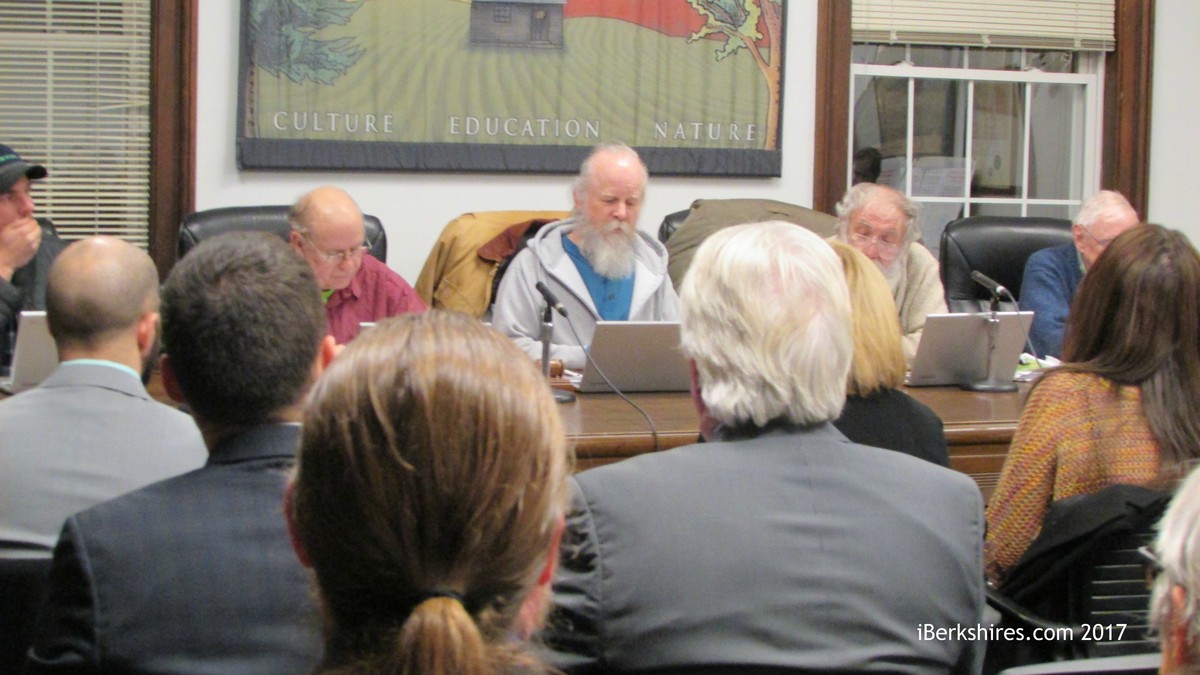Williamstown ZBA Sends Cell Tower Applicant Back to Drawing BoardBy Stephen Dravis, iBerkshires Staff
04:01AM / Friday, December 15, 2017 | |
 A Verizon balloon test Wednesday morning simulates the height of a proposed monopole cell tower at the junction of Routes 2 and 7 in Williamstown. A Verizon balloon test Wednesday morning simulates the height of a proposed monopole cell tower at the junction of Routes 2 and 7 in Williamstown. |

Andrew Hoar chairs Thursday's ZBA meeting, which heard mostly complaints about the cell tower proposal.
WILLIAMSTOWN, Mass. — The Zoning Board of Appeals on Thursday asked Verizon to consider a couple of alternatives for its proposed cell tower on Cold Spring Road at the junction of Routes 2 and 7.
The board continued the public hearing on the project, which requires a special permit and two zoning variances.
The project has been the subject of intense opposition from many town residents, who question it on several grounds that boil down to two essential issues: the public safety threat posed by a tower so close to a state highway and the visual impact in an especially scenic part of town — both to nearby residents and the tourists essential to Williamstown's economy.
The safety issue is germane to one of the two zoning variances sought. According to the town's cell tower bylaw, any structure must be set back from abutting properties by the height of the tower plus 50 feet.
In the case of Verizon's proposed 100-foot tower, that would mean a 150-foot setback, but the carrier is asking for a variance to put the tower 85 feet from the road. The applicant argues that an intentional, engineered flaw that allows the top of the tower to essentially fold on itself at the 70-foot mark in the event of a failure because of severe wind means that the 85 feet is a sufficient setback to keep it out of the roadway.
The aesthetic argument factors into the special permit required by the bylaw.
ZBA member Keith Davis proposed an alternative that he believes would address both issues and satisfy another element of the bylaw: a preference for locating cell towers on town-owned properties.
"Did you investigate the Margaret Lindley Park property?" Davis asked Verizon's development team.
Davis suggested that an area of the park that has one remaining abandoned tourist cabin and which is accessible by an abandoned road off the main drive to the swimming hole could host a cell tower and keep it largely out of sight from the southern gateway to the town.
"I'm thinking it has possibly several advantages," Davis said. "One, it would bury the tower and keep it out of people's sight lines. It would bring in income for the town. And there is an access road to it."
Although Verizon looked at 24 potential sites for the tower, including several suggested by the town, Margaret Lindley Park, which is controlled by the town's Conservation Commission, was not on the list.
Verizon's radio frequency engineer told the board he would be happy to do due diligence on the Margaret Lindley Park site. The ZBA asked Verizon's team to conduct a study and have a conversation with the Con Comm about potentially leasing part of the land before the board's Jan. 18 meeting.
Verizon's attorney said the company would be happy to do the analysis and hoped to have the property assessed by January, but the board left open the door to another continuation of the hearing, into February, if more time was needed.
The board also asked Verizon to look at another location for the monopole cell tower on the property that is the subject of the application, the former Taconic Restaurant. In response to queries from ZBA Chairman Andrew Hoar, Verizon's designer said Thursday it is conceivable it may find an area of the Taconic property that puts the tower 100 feet from the road — still in an area that would require a variance but a safer distance from Route 2 (the Taconic Trail).
The ZBA also asked Verizon to take another look at its screening for the ground facility that supports the tower and to consider either underground or at least covered storage for a 500-gallon propane tank needed to run a backup generator on the site.
In addition to several questions from the board, Thursday's hearing featured comments from the floor from nine residents — eight opposed to the project and one in support of it.
Verizon says it needs to put a tower on the site to fill a 2-mile gap in cell coverage along Cold Spring Road (U.S. Route 7).
"Verizon is a reliability company, and we work hard to see that our customers have the service where they need it," radio frequency engineer Jay Latorre told the ZBA. "There is a stretch of two miles or more along Route 7 where we're less than reliable. A pretty big portion is extremely weak, almost what they refer to as a ‘dead zone.'
"My job was to find a location for a facility to eliminate this."
Residents speaking in opposition to the project argued — both from the podium and from their seats — that the gap in coverage was smaller than Verizon claimed.
But their bigger concern was the impact that the tower would have on the community.
"The views from the public ways and developed properties should be given due consideration to make sure the benefit to the town outweighs the impact," said William Bowden of Park Street. "I call on the ZBA to pay due attention to these provisions in the town bylaw before it considers granting a special permit or event thinks about granting two variances."
Joan Wright of Old Farm Way argued that Verizon's simulations that show how the tower might be obscured by the existing tree line do not take into account the age of the trees.
"They lose branches regularly, and they die and fall down or they get blown down," Wright said. "This would be, by no means, a reliable or enduring screen for a 100-foot tower, regardless of what the test balloon may indicate now."
Anne Hogeland of Cold Spring Road argued that Verizon's repeated statements that the tower would be 100 feet tall are not supported by its own drawings, which indicate the height would be 110 feet, with another four feet tacked on for the antennae.
"Safety is key here," Hogeland said. "A variance allowing the tower to be 85 feet from the public way would mean it's closer to the public way than it is tall, meaning it could fall right in the public way."
Architect Doug Roberts of North Andover's Hudson Design Group explained that in addition to the structured fault that allows the pole to collapse on itself, the monopoles are designed to survive sustained winds of 95 mph with gusts of up to 115 mph. He noted that recent images of communities devastated by hurricanes on Puerto Rico show that often the only structure left intact is the cell tower.
He did, on the other hand, agree with ZBA member Leigh Short about the desirability of placing some sort of canopy — or burying — the propane tank in order to prevent downed trees from damaging that feature of the tower.
That is unlikely to address the kind of concern raised by Sweet Brook Road's Pam Weatherbee, one of several residents who focused on the aesthetic impact of the proposed tower.
"Unfortunately, cell towers are ugly," Weatherbee said. "They are ugly, industrial structures. Here it would be set in a rather attractive residential and tourist business area. You must consider the businesses there. There is a very pretty motel which always beautifies its grounds. There's the bakery. There's a couple of residences.
"I think all would be affected by this structure."
Moments later, the owner of the "very pretty motel," the Berkshire Hills Country Inn, had a different take on the issue.
"I tell you, cells have become a way of life," Ron Smith said. "I lose business because we don't have cell service. Customers check in, find that they can't have cell service, and they check out. They don't come back.
"If one of those kids [at Margaret Lindley Park] gets hurt, and they want to call for help, they can't. Someone at night gets stuck with their car, it's cold out, they're having a baby. They can't get cell service. Cell phones are a way of life.
"You should allow them to put up the tower as soon as possible."
| 
